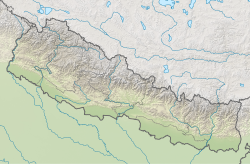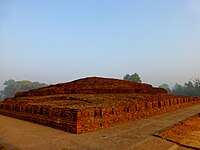Kapilavastu
 Procession of king Suddhodana from Kapilavastu, proceeding to meet his son the Buddha walking in mid-air (head raised at the bottom of the panel), and to give him a Banyan tree (bottom left corner). The dream of Maya at the top of the panel is a sure marker of Kapilavastu. Sanchi.
Procession of king Suddhodana from Kapilavastu, proceeding to meet his son the Buddha walking in mid-air (head raised at the bottom of the panel), and to give him a Banyan tree (bottom left corner). The dream of Maya at the top of the panel is a sure marker of Kapilavastu. Sanchi.

| Pilgrimage to |
| Buddha's Holy Sites |
|---|
 |
| The Four Main Sites |
| Four Additional Sites |
| Other Sites |
Kapilavastu was an ancient city in the eastern Gangetic plains of the Indian subcontinent which was the capital of the clan gaṇasaṅgha or "republic" of the Shakyas in the late Iron Age, around the 6th and 5th centuries BC. King Śuddhodana and Queen Māyā are believed to have lived at Kapilavastu, as did their son Prince Siddartha Gautama (Gautama Buddha) until he left the palace at the age of 29.
Buddhist texts such as the Pāli Canon say that Kapilavastu was the childhood home of Gautama Buddha, on account of it being the capital of the Shakyas, over whom his father ruled. Kapilavastu is the place where Siddhartha Gautama spent the first 29 years of his life. According to Buddhist sources the name Kapilvatthu means "tawny area", due to the abundance of reddish sand in the area. Most foreign accounts from the medieval period, particularly from China, described Kapilavastu as being part of "Central India".
Kapilavastu never became a major pilgrimage site like Buddha's birthplace at Lumbini not far away, which would have left unmistakable remains. The settlement was probably never as large as depictions in early Buddhist art suggest, and after the decline of Buddhism in India its location faded into obscurity. There are now two sites near the border between Nepal and India which are claimed as Kapilavastu — Piprahwa in Uttar Pradesh, India and Tilaurakot in Nepal. Finds at the Piprahwa (including a reliquary found inside a mud stupa) indicate Buddhist activity dating to the 5th–4th century BCE, around the time of the death of the Buddha.
Search for Kapilavastu
The 19th-century search for the historical site of Kapilavastu followed the accounts left by Faxian and later by Xuanzang, who were Chinese Buddhist monks who made early pilgrimages to the site. Some archaeologists have identified present-day Tilaurakot, Nepal, while others have identified present-day Piprahwa, India as the location for the historical site of Kapilavastu, the seat of governance of the Shakya state that would have covered the region. Both sites contain archaeological ruins. Those at Piprahwa show it was a significant early Buddhist site with a stupa and monasteries, and probably relics of the Buddha.
Proposed sites
-
Proposed site of Suddhodanda's Palace at Tilaurakot
-
 Stupa at Piprahwa
Stupa at Piprahwa
Ancient depictions
-
 Maya's dream of an elephant during her conception of the Buddha, an identifier of the city of Kapilavastu.
Maya's dream of an elephant during her conception of the Buddha, an identifier of the city of Kapilavastu.
-
 The departure of the Buddha from Kapilavastu, Sanchi, Stupa 1, Northern Gate.
The departure of the Buddha from Kapilavastu, Sanchi, Stupa 1, Northern Gate.
Notable people
- Puṇṇa Mantānīputta – one of the Buddha's ten principal disciples
- Anuruddha – among the ten principal disciples and also a cousin of the Buddha
- Rāhula – the only son of the Buddha
- Ānanda – primary attendant of the Buddha and among the ten principal disciples
References
- Marshall, John (1918). Guide To Sanchi, Calcutta: ASI; p.64]
- ^ Trainor, K (2010). "Kapilavastu". In Keown, D; Prebish, CS (eds.). Encyclopedia of Buddhism. Milton Park, UK: Routledge. pp. 436–7. ISBN 978-0-415-55624-8.
- Kapila, PTS Pali English Dictionary. Link: https://suttacentral.net/define/kapila
- Suttacentral
- Mosca, Matthew (2020). "Indian Mendicants in Ming and Qing China: A Preliminary Study". India-China: Intersecting Universalities.
- ^ Srivastava, KM (1980). "Archaeological Excavations at Piprāhwā and Ganwaria and the Identification of Kapilavastu". The Journal of the International Association of Buddhist Studies. 13 (1): 103–10.
- Beal, Samuel (1884). Si-Yu-Ki: Buddhist Records of the Western World, by Hiuen Tsiang. 2 vols. Translated by Samuel Beal. London. 1884. Reprint: Delhi. Oriental Books Reprint Corporation. 1969. Volume 1
- Beal, Samuel (1911). The Life of Hiuen-Tsiang. Translated from the Chinese of Shaman (monk) Hwui Li by Samuel Beal. London. 1911. Reprint Munshiram Manoharlal, New Delhi. 1973. Internet Archive
- Li, Rongxi (translator) (1995). The Great Tang Dynasty Record of the Western Regions. Numata Center for Buddhist Translation and Research. Berkeley, California. ISBN 1-886439-02-8
- Watters, Thomas (1904). On Yuan Chwang's Travels in India, 629–645 A.D. Volume1. Royal Asiatic Society, London.
- Tuladhar, Swoyambhu D. (November 2002), "The Ancient City of Kapilvastu – Revisited" (PDF), Ancient Nepal (151): 1–7
- Hellier, Chris (March 2001). "Competing Claims on Buddha's Hometown". Archaeology.org. Retrieved 21 March 2011.
- Srivastava, KM (1979), "Kapilavastu and Its Precise Location", East and West, 29 (1/4): 61–74, JSTOR 29756506(registration required)
- Sharda, Shailvee (4 May 2015), "UP's Piprahwa is Buddha's Kapilvastu?", Times of India
- "Kapilavastu". Retrieved 1 March 2011.
- Huntington, John C (1986), "Sowing the Seeds of the Lotus" (PDF), Orientations, September 1986: 54–56, archived from the original (PDF) on 28 November 2014
Bibliography
- Coningham, Robin; Young, Ruth (2015). The Archaeology of South Asia: From the Indus to Asoka, c.6500 BCE–200 CE. Cambridge University Press. pp. 438–440. ISBN 978-1-316-41898-7.